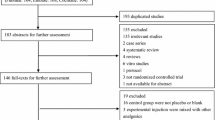Abstract.
Introduction: The relief of postoperative pain remains one of the most important goals for adequate surgical patient care. Methods: Prospective, randomised, double-blinded study, including 118 patients (67 M;/ 51 F; median age 43 years, min. 18, max. 74). Two groups were formed. In the verum group a wound instillation with ropivacaine was performed, in the control group not. Intensity of pain, demand for analgesics and satisfaction of the patient were evaluated postoperatively. In 10 patients ropivacaine plasma levels were measured. Results: Significant postoperative pain relief and a decrease in analgesic consumption were found on instillation of ropivacaine. Compared to the control group, patients receiving ropivacaine were significantly more satisfied with the postoperative pain management. Potential toxic plasma levels were not found. Conclusion: By the presented method, the surgeon actively contributes to a significant reduction in postoperative pain and analgesic consumption. Furthermore, the patient's benefit is reflected by higher satisfaction with the pain management. Complications due to toxic plasma levels are not seen.
Zusammenfassung.
Einleitung: Die Verminderung postoperativer Schmerzen gehört nach wie vor zu den essentiellen Aufgaben einer adäquaten chirurgischen Patientenversorgung. Methoden: In eine prospektive, randomisierte, doppelblinde Vergleichsstudie wurden über einen Einjahreszeitraum 118 Patienten (67 Männer/51 Frauen; Alter median: 43 Jahre, min. 18; max. 74) eingeschlossen. Es erfolgte eine Einteilung in 2 Gruppen. In der Verumgruppe wurde intraoperativ eine Wundinstillation mit Ropivacain vorgenommen, in der Kontrollgruppe nicht. Schmerzintensität, Analgetikaverbrauch und Patientenzufriedenheit wurden postoperativ ermittelt. Bei 10 Patienten wurden die Plasmaspiegel bestimmt. Ergebnisse: Durch das Verfahren werden postoperative Schmerzen sowie Schmerzmittelbedarf signifikant verringert. Die Zufriedenheit der Patienten mit der postoperativen Schmerzbehandlung ist größer als in der Kontrollgruppe. Es wurden keine potentiell toxischen Ropivacain-Plasmaspiegel gemessen. Schlussfolgerungen: Durch die beschriebene Methode kann der Chirurg zur signifikanten Verringerung postoperativer Schmerzen und des Analgetikabedarfs beitragen. Weiterhin kann eine größere Patientenzufriedenheit erreicht werden. Mit Komplikationen als Folge toxischer Plasmaspiegel ist nicht zu rechnen.
Similar content being viewed by others
Author information
Authors and Affiliations
Rights and permissions
About this article
Cite this article
Korner, J., Lill, H., Hepp, P. et al. Perioperative lokale Instillation von Ropivacain zur postoperativen Schmerzreduktion in der Extremitätenchirurgie Eine prospektiv randomisierte Doppelblindstudie. Chirurg 72, 1353–1359 (2001). https://doi.org/10.1007/s001040170042
Issue Date:
DOI: https://doi.org/10.1007/s001040170042




